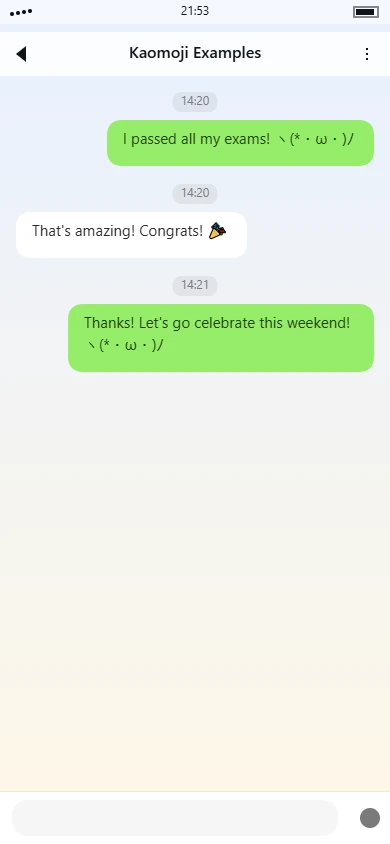( ´ ω ` ) kaomoji Meaning | Usage Tips

Overview
The kaomoji
( ´ ω Visual Structure Explanation
This kaomoji uses symmetrical parentheses
()´`ωSymbol Breakdown
- Parentheses
(
: These curved brackets form the outer boundary of the face, creating a rounded head shape that appears soft and approachable) - Apostrophe-like characters
´
: These diacritical marks serve as the eyes, with the left eye`
angled upward and the right eye´
angled downward, creating a gentle, slightly asymmetrical gaze` - Greek letter omega
: Positioned centrally as the mouth, this character's rounded, wavy shape suggests a small, content smile without showing teethω - Spacing arrangement: The careful placement of characters creates balanced facial proportions, with the eyes positioned slightly above the mouth level
Emotion & Aesthetic Analysis
The emotional tone conveyed by this kaomoji is one of quiet contentment and mild happiness. The closed-mouth smile created by the
ωCompared to more exaggerated kaomoji like
(^_^)(≧▽≦)This kaomoji finds common usage in various online contexts, particularly in text-based communication where tone can be difficult to convey. It works well as a response to good news, a way to express gentle agreement, or as a polite acknowledgment of someone's message. The expression's restrained nature makes it versatile across different conversation types, from casual chats to more formal digital correspondence where excessive emotional display might be inappropriate.
Tag categories
Use tags to quickly understand this kaomoji.
Expression tags
Click tags to explore related kaomoji.
Usage guide
Usage Guide for ( ´ ω ` )
The kaomoji ( ´ ω
) is one of those wonderfully versatile expressions that has found a permanent home in casual online communication. At its core, it represents a soft, slightly bashful, or contented expression, often used to convey a sense of gentle happiness, shy satisfaction, or playful innocence. The small, downturned eyes (and ωCommon Use Cases
- Expressing quiet contentment after receiving a compliment or a small gift.
- Reacting to a mildly embarrassing but ultimately funny story shared by a friend.
- Appending to a statement where you're admitting a minor fault or a silly mistake.
- Showing gentle appreciation for something cute, like a picture of a pet or a child's drawing.
- Conveying a sense of "oh, you" in response to friendly teasing or a playful jab.
- Signaling that you're feeling cozy, relaxed, and generally at ease during a conversation.
- Adding a soft, non-sarcastic tone to a thank you or an apology to make it feel more genuine.
- Reacting to a puzzle or a riddle that you find charmingly confusing.
- Expressing a feeling of happy resignation, like when you give in to a friend's request.
- Using in a gaming context after a narrow victory or a funny, non-serious defeat.
- Commenting on a piece of art or music that gives you a warm, fuzzy feeling.
- As a gentle, non-intrusive way to bump a conversation or show you're still listening in a group chat.
Example Conversations
-
Friend A: I baked cookies and may have eaten half the batch already... Friend B: Well, they were really good! ( ´ ω ` )
-
Player 1: I can't believe I fell off the map right at the end. Player 2: It happens to the best of us. We'll get it next time! ( ´ ω ` )
-
User A: Your cat is so adorable in that sunbeam. User B: He knows it, and he uses it to get extra treats. ( ´ ω ` )
-
Colleague A: Sorry for the slow reply, my afternoon meeting ran long. Colleague B: No worries at all, I figured you were busy. ( ´ ω ` )
-
Sibling A: Remember that time you tried to cut your own hair? Sibling B: Don't remind me... it took months to grow out. ( ´ ω ` )
-
Post: Just finished a great book and now I don't know what to do with my life. Comment: That's the best and worst feeling. ( ´ ω ` )
Important Notes
- Avoid Formal Contexts: This kaomoji is firmly in the realm of casual, friendly communication. Do not use it in formal emails, official work correspondence, serious discussions, or when delivering bad news, as it will appear unprofessional and dismissive of the situation's gravity.
- Tone is Key: The expression's power lies in its softness. It is not used for strong emotions like extreme joy, anger, or sadness. Using it in a context that calls for a more powerful reaction can make you seem detached or insincere. It's a whisper, not a shout.
- Cultural Nuance: While widely understood in global online spaces, its primary roots are in Japanese net culture. On platforms like Twitter, Discord, or in anime/manga fan communities, it's instantly recognizable. In more general or mainstream social media contexts, it might be slightly more niche, but its meaning is usually clear from the surrounding conversation.
Usage examples
Real conversation samples that feature this kaomoji.

Example 1

Example 2
Related kaomoji
You might also enjoy these kaomoji.